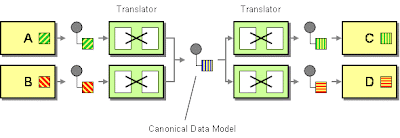In WebLogic Integration, process automation is implemented through Java Process Definitions (JPDs). A JPD is an annotated Java class that is compiled into an EJB, using the annotations to generate code. WLI's sweet spot is in
visually designing
long-lived,
asynchronous,
multi-step processes that would otherwise be prohibitively complex to implement.
Service Orchestration is typically performed in:
- Java Process Definitions in WebLogic Integration.
- Process Models in AquaLogic BPM Suite.
- Proxy Services in AquaLogic Service Bus.
Simple service orchestration can be implemented in Apache Beehive Java Web Services in WebLogic Server.
If an asynchronous operation is invoked on the Web Service, the client may proceed with processing in parallel with the service processing. However, the client may require a response to the asynchronous call. One way to accomplish this is to leverage a callback whereby the service calls an interface on the client. However, callbacks cannot always be used to nitify the client of request completion. To handle this, a Web Service can provide a polling interface.
Polling and
Callbacks are two mechanisms to achieve asynchrony. You might implement both approaches, to handle all situations.

